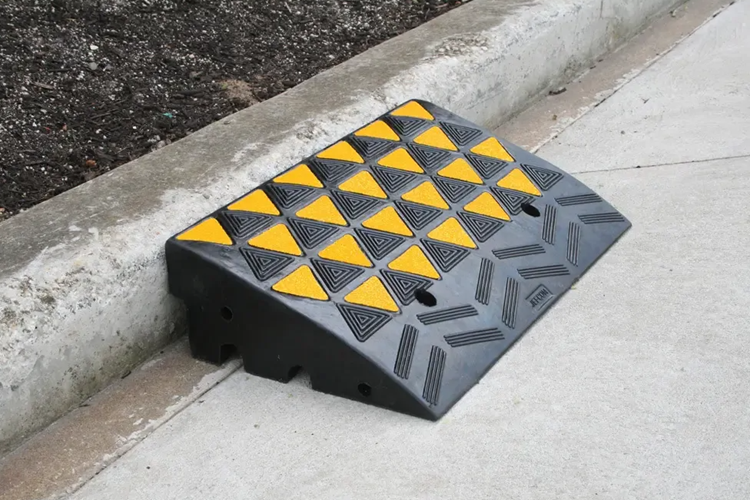Ramps are simple yet effective devices that ensure accessibility and safety in numerous scenarios. They come in various sizes and types, and are used when loading and unloading objects from trucks, vans and trailers; providing simplified access for wheelchair users and ensuring smooth transitions and pathways for pedestrians, trolleys, bicycles, prams and vehicles.
One of the more versatile types are kerb ramps. In their basic form, these are inclined surfaces used to bridge the height difference between pavements and roads with other raised surfaces. They go by different names depending on where you live, from curb cuts or curb ramps in the States and pram ramps and dropped kerbs in the UK. The basic function of a kerb ramp is to create an accessible pathway that is otherwise blocked by a raised kerb. This ensures that moving wheeled vehicles or objects up kerbs is done smoothly and safely.
Benefits of Kerb Ramps
- Enhanced safety and convenience: Kerb ramps are crucial in providing safety for vehicles and pedestrians when moving between surfaces in different elevations. They eliminate trip hazards and the risk of falls with a smooth incline over the kerb drop. This seamless transition also reduces damage to wheels and casters, or suspension components in vehicles when crossing kerbs or uneven surfaces.
- Accessibility: Ensure easier access for anyone using wheelchairs, prams, trolleys, hand trucks, bicycles and other wheeled vehicles. Kerb ramps are key design features in public spaces, promoting the use of different transportation methods and inclusion for a wider range of users
- Durability: Optioned in a range of durable materials, from rubber and concrete to durable plastics, these ramps provide security and stability with high weight loadings and dependable mounting hardware to secure them in place.
- Quick installation: Modern construction materials and simplified designs have made installing and maintaining ramps quick and easy.

source: rampitup.com.au
Common Types
Portable Pedestrian Ramps
Lightweight, easy to transport and usually made from durable recycled plastics that also boasts high visibility, portable pedestrian kerb ramps are common items in pavements, nature strips, car parks and commercial and retail buildings. Key features are gradual inclines for smooth transitioning, anti-slip surfaces to prevent hazards, and lengths and widths to accommodate larger wheeled vehicles. Look for raised sides to prevent wheels rolling off edges, foldable or stackable designs for simple storage and transport and recessed fixing points for easy installation and enhanced stability.
Vehicle and Car Ramps
Provide easier entry and exit to raised areas with cost-effective and convenient car kerb ramps. These ensure a high level of safety, functionality and durability with exceptionally high load capacities, the same high-vis markings (as smaller portable types) and non-slip, textured surfaces to grip wheels, casters and tyres in cars, trucks, bikes, ATVs, as well as wheelchairs, trolleys, hand trucks and other wheeled vehicles. Most types include bevelled designs to allow access and a smooth transition from any angle and drainage channels to remove rainwater.
Choose modular types to get ramps in the desired lengths and heights, with multiple ramps placed side-by-side. Or permanent car ramps (usually in steel or concrete) as more secure types with higher load ratings for frequent use.
Key Buying Considerations
- Length and width: A kerb ramp in the correct dimensions provides a gentle incline and a smooth transition between areas of varying heights. The ramps should be long enough to extend from the footpath, pavement, or road to the top of the kerb. Inclines of no more than 1:8 (as per Australian Standard 1428.1-2021) are recommended. The same standard stipulates widths of at least 1 metre for areas with wheelchair access. For other vehicles, including cars, widths vary from 300mm in end modules to 800mm in centre modules.
- Weight capacity: Smaller pedestrian and wheelchair ramps have ample loadings ranging between 250 and 500 kilograms, with most averaging 300 kilos. Larger, heavy-duty vehicle ramps start at 1000 kilograms, with the biggest types meant for trucks and heavy-machinery supporting up to 20 tonnes.
- Materials: These ramps are constructed from various materials, including rubber, aluminium, stainless steel, engineered plastics and concrete. Materials are chosen by application and settings as well as factors such a rated weight capacity. Aluminium ramps are lightweight, high-strength and corrosion resistant and are suitable for numerous uses and environments. Steel benefits from improved strength, specifically with heavier loads, but does require anti-corrosive coatings. Rubber is a durable, weather-resistant and anti-slip option regularly seen in pedestrian and car ramps in modular designs with good weight capacity. Plastic ramps are lightweight and portable (ideal for temporary uses in varied locations), but will have the lowest weight loadings of any material. Concrete is used in permanent curb ramps, usually as design features built into pavements, footpaths and driveways.
- Safety features: High-vis, reflective markings (in bright yellow and black colour schemes) ensure visibility and safety in low-light and areas with heavy pedestrian and vehicle traffic. Non-slip surfaces, either textured rubber or plastic inserts or grated metal are combined with side rails to prevent accidents, Moreover, integrated channelling systems provides drainage and keep ramps dry.
- Ease of use: Choose ramps that are lightweight, include handles for easier transport, are stackable or foldable and take up less space when stored.

